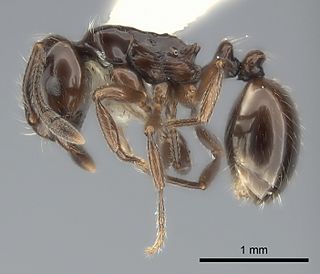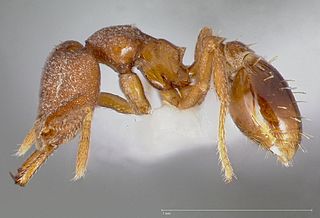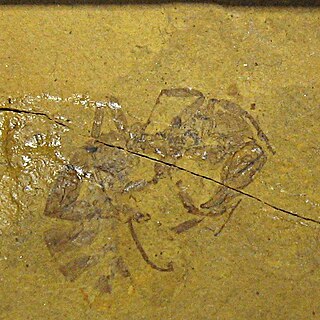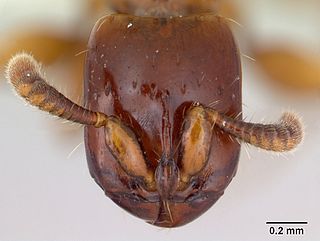
Dorylinae is an ant subfamily, with distributions in both the Old World and New World. Brady et al. (2014) synonymized the previous dorylomorph subfamilies under Dorylinae, while Borowiec (2016) reviewed and revised the genera, resurrecting many genera which had previously been merged. Dorylinae genera are suggested to have evolved sometime between 102 to 74 million years ago, subsequently undergoing rapid adaptive radiation events during their early history.

Myrmecia is a genus of ants first established by Danish zoologist Johan Christian Fabricius in 1804. The genus is a member of the subfamily Myrmeciinae of the family Formicidae. Myrmecia is a large genus of ants, comprising at least 93 species that are found throughout Australia and its coastal islands, while a single species is only known from New Caledonia. One species has been introduced out of its natural distribution and was found in New Zealand in 1940, but the ant was last seen in 1981. These ants are commonly known as bull ants, bulldog ants or jack jumper ants, and are also associated with many other common names. They are characterized by their extreme aggressiveness, ferocity, and painful stings. Some species are known for the jumping behavior they exhibit when agitated.

Myrmeciinae is a subfamily of the Formicidae, ants once found worldwide but now restricted to Australia and New Caledonia. This subfamily is one of several ant subfamilies which possess gamergates, female worker ants which are able to mate and reproduce, thus sustaining the colony after the loss of the queen. The Myrmeciinae subfamily was formerly composed of only one genus, Myrmecia, but the subfamily was redescribed by Ward & Brady in 2003 to include two tribes and four genera. An additional three genera, one form genus, and 9 species were described in 2006 from the Early Eocene of Denmark, Canada, and Washington. Subsequently an additional fossil genus was moved from the family Rhopalosomatidae in 2018, and a new genus was described in 2021.

Adetomyrma venatrix, more commonly known as the Dracula ant, so named because of its grisly feeding habits of drinking the blood of its young, is an endangered species of ants endemic to Madagascar. Workers of this species are blind. The species was described as the type species of Adetomyrma in 1994, with the genus being an atypical member of its tribe.

Iridomyrmex is a genus of ants called rainbow ants first described by Austrian entomologist Gustav Mayr in 1862. He placed the genus in the subfamily Dolichoderinae of the family Formicidae. It has 79 described species and five fossil species. Most of these ants are native to Australia; others are found in Asia and Oceania, and they have been introduced to Brazil, New Zealand, and the United Arab Emirates. Fossil species are known from China, France, and the United States.

Monomorium bidentatum is a species of ant in the subfamily Myrmicinae. It is endemic to two South American countries, Chile and Argentina.

Strumigenys is a genus of ants in the subfamily Myrmicinae.

Prionomyrmex is an extinct genus of bulldog ants in the subfamily Myrmeciinae of the family Formicidae. It was first described by Gustav Mayr in 1868, after he collected a holotype worker of P. longiceps in Baltic amber. Three species are currently described, characterised by their long mandibles, slender bodies and large size. These ants are known from the Eocene and Late Oligocene, with fossil specimens only found around Europe. It is suggested that these ants preferred to live in jungles, with one species assumed to be an arboreal nesting species. These ants had a powerful stinger that was used to subdue prey. In 2000, it was suggested by Cesare Baroni Urbani that the living species Nothomyrmecia macrops and a species he described both belonged to Prionomyrmex, but this proposal has not been widely accepted by the entomological community. Instead, scientists still classify the two genera distinctive from each other, making Nothomyrmecia a valid genus.

Electromyrmococcus is an extinct genus of mealybug in the Pseudococcidae subfamily Rhizoecinae. The genus currently contains three species, all from the early Miocene, Burdigalian stage, Dominican amber deposits on the island of Hispaniola.

Myrmeciites is an extinct form genus of bulldog ants in the subfamily Myrmeciinae of the family Formicidae, which contains three described species and two fossils not placed beyond the genus level. Described in 2006 from Ypresian stage deposits, all three of the described species and one unplaced fossil are from British Columbia, Canada, while the second unplaced fossil is from Washington State, USA. These ants were large, with the largest specimens collected reaching 3 centimetres (1.2 in). The behaviour of these ants would have been similar to extant Myrmeciinae ants, such as solitary foraging, nesting either in the soil or trees, and leaving no pheromone trail to food sources. Due to the poor preservation of these ants, their phylogenetic position among Myrmeciinae is unclear, and no type species has been designated. These ants are classified as incertae sedis in Myrmeciinae, but some writers have classified it as incertae sedis within the insect order Hymenoptera. This reclassification, however, has not been accepted; instead, Myrmeciites remains in Myrmeciinae.

Ochetellus is a genus of ants first described by Steve Shattuck in 1992. He placed it in the subfamily Dolichoderinae of the family Formicidae. The ants in this genus are small and black in colour; workers measure 1.75 to 3 millimetres in length, the males at around 1.6 millimetres (0.06 in) are smaller, and the queens are the largest, reaching 4 millimetres (0.16 in). There are seven described species and three described subspecies that mostly live in Australia in a wide variety of habitats, but some species are found in Asia. One species, Ochetellus glaber, has been introduced into New Zealand and the United States.

Acanthostichus is a predatory and predominantly subterranean genus of ant in the subfamily Dorylinae. They are found in the New World, from the southern United States to Uruguay, Paraguay and northern Argentina. They are probably common, but due to their subterranean nature, they are seldom collected or seen.

Brownimecia is an extinct genus of ants, the only genus in the tribe Brownimeciini and subfamily Brownimeciinae of the Formicidae. Fossils of the single identified species, Brownimecia clavata, are known from the Middle Cretaceous of North America. The genus is one of several ants described from Middle Cretaceous ambers of New Jersey. Brownimecia was initially placed in the subfamily Ponerinae, until it was transferred to its own subfamily in 2003; it can be distinguished from other ants due to its unusual sickle-like mandibles and other morphological features that makes this ant unique among the Formicidae. The ant is also small, measuring 3.43 millimetres (0.135 in), and a stinger is present in almost all of the specimens collected. The morphology of the mandibles suggest a high level of feeding specialization.

Haidomyrmex is an extinct genus of ants in the formicid subfamily Haidomyrmecinae, and is one of nine genera placed in the subfamily Haidomyrmecinae. The genus contains three described species Haidomyrmex cerberus, Haidomyrmex scimitarus, and Haidomyrmex zigrasi. All three are known from single Late Cretaceous fossils which have been found in Asia. H. cerberus is the type species and Haidomyrmex the type genus for the subfamily Haidomyrmecinae.

Burmomyrma is an extinct genus of aculeate hymenopteran, suggested to be an ant. The genus contains a single described species, Burmomyrma rossi. Burmomyrma is known from a single Middle Cretaceous fossil which was found in Asia.

Acanthostichus hispaniolicus is an extinct species of ant in the subfamily Dorylinae known from a group of possibly Miocene fossils found on the Caribbean island of Hispaniola. A. hispaniolicus is the first species of the ant genus Acanthostichus to have been described from fossils found in Dominican amber, and is the only species of Acanthostichus found in the West Indies.

Archimyrmex is an extinct genus of ant in the formicid subfamily Myrmeciinae, described by palaeoentomologist Theodore Cockerell in 1923. The genus contains four described species, Archimyrmex rostratus, Archimyrmex piatnitzkyi, Archimyrmex smekali and Archimyrmex wedmannae. Archimyrmex is known from a group of Middle Eocene fossils which were found in North America, South America, and Europe. The genus was initially placed in the subfamily Ponerinae, but it was later placed in Myrmeciinae; it is now believed to be the ancestor of the extant primitive genus Myrmecia from Australia. Despite this, Archimyrmex is not a member to any tribe and is regarded as incertae sedis within Myrmeciinae. However, some authors believe Archimyrmex should be assigned as incertae sedis within Formicidae. These ants can be characterised by their large mandibles and body length, ranging from 13.2 to 30 mm. They also have long, thin legs and an elongated mesosoma (thorax) and petiole.

Acanthostichus arizonensis is a species of ant belonging to the genus Acanthostichus. It was described by Mackay in 1996. These ants are distributed in the United States and Mexico.

Acanthostichus brevicornis is a species of ant belonging to the genus Acanthostichus. Emery first described the species in 1894, and a synonym was given by Bruch in 1924. Their distribution is in South America, in the countries of Argentina, Brazil, Guyana, Paraguay and Suriname.


















